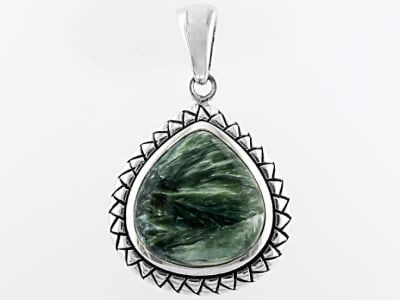Seraphinite was named after Seraphim, the highest rank of angels in the Bible, due to the feather-like appearance of its chatoyant fibers. The stone usually has a dark green to gray color with silvery shimmer caused by mica inclusions. This unique, somewhat mystic-looking gem is often used for carvings, decorative pieces and cut as cabochons.
General Information
Common Name
Seraphinite
Species
Seraphinite
Transparency
Transparent - Translucent
Dispersion
Strength: None
Refractive Index
1.571-1.597
Birefringence
0.005-0.011
Optic Character
Biaxial
Optic Sign
Positive or Negative
Polariscope Reaction
Aggregate (AGG), Doubly Refractive (DR)
Fluorescence
SWUV: Inert
LWUV: Inert
LWUV: Inert
Pleochroism
Unobservable
Hardness
2-2.5
Specific Gravity
2.600-3.020
Toughness
Poor
Inclusions
Mica inclusions give seraphinite a silvery and feathery shimmer.
Luster
Pearly, Dull, Greasy
Fracture
Uneven
Cleavage
Perfect, in one direction
Chemical Name
magnesium iron aluminum silicate hydroxide
Chemical Formula
(Mg,Fe2+)5Al(Si3Al)O10(OH)8
Crystal System
Monoclinic
Chemistry Classification
Silicate
Seraphinite Colors
-
 Green
Green -
 Multi-color
Multi-color -
 White
White
Alternate Names
Clinochlore
Countries of Origin
Russian Federation; Unknown; Australia

